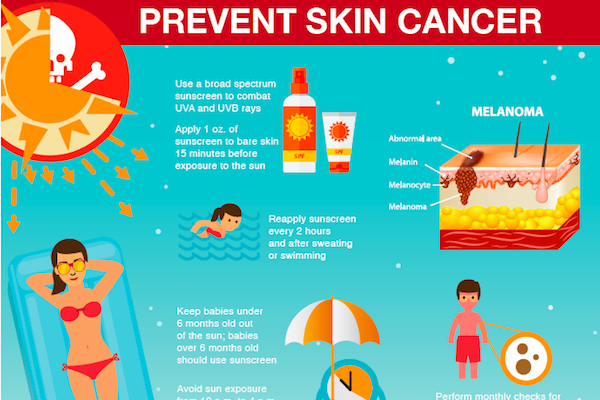
Summertime means more fun in the sun for North Texans, and along with it, a greater risk of sun-related skin damage, including skin cancer.
Approximately one in five people in the U.S. develops skin cancer during the course of their lives. Many patients can be successfully treated when the disease is detected and diagnosed in its early stages. If left undetected or untreated, however, skin cancer can spread throughout the body. Unfortunately, myths abound regarding skin cancer prevention and sun safety.
Let’s go over five common myths and five truths about skin cancer prevention that we discuss with our patients.
5 myths about skin cancer
1. Glass protects the skin from UV damage
In most vehicles and buildings, window glass blocks ultraviolet B (UVB) rays, but not UVA rays – and that includes airplanes. Pilots who spend a lot of time behind glass at high altitudes have an increased risk of skin cancer. Don’t let window glass give you a false sense of security. On your daily commute, when you’re going on a long car trip, and even when you’re sitting at your desk near a window, protect your skin. The rays can cause damage, even if it’s not a “burn” or visible to the naked eye.
2. Sun exposure is necessary to prevent vitamin D deficiency
Your body gets its Vitamin D from a combination of both sun exposure and diet. Using common sense skin protection rarely interferes with this. Research shows that 10-15 minutes of sun exposure a day is generally enough – many people can get that amount by walking from the office to their car each day. If you are low in vitamin D, it’s much safer to increase levels by using an oral supplement rather than excessively exposing your skin to the sun, which comes with a risk of skin cancer.
3. Sunscreen is waterproof
Actually, sunscreen is water resistant, not waterproof. It can come off in the water, and you can sweat it off as well. We recommend that you wait 10 to 15 minutes after applying sunscreen before getting wet or sweating to reduce the risk of it washing away. Reapply a layer of sunscreen within one to two hours of being in the water or being active.
4. My skin is safe if it doesn’t burn
While sunburns are a definitive sign that your skin has received significant UV damage, you can still be doing harm without a sunburn. Just as “light smokers” still increase their risk of lung cancer, people who regularly “tan” are still damaging their skin and increasing their risk of skin cancer. Even people who’ve never burned can get skin cancer because sun exposure over time is such a strong risk.
5. Eating certain foods can prevent sunburns
While eating antioxidant-rich foods such as fruits and vegetables is healthy in many ways, a nutritious diet alone will not prevent sunburns or skin cancer. Research shows the impacts of healthy eating on preventing sunburns are incredibly small – offering protection similar to an SPF of just 3.
Now that we’ve covered the myths, let’s talk about some skin cancer truths patients should consider.
5 truths about skin cancer
1. Ultraviolet (UV) rays can cause skin cancer
We know that UV rays and overexposure to the sun can increase the risk of skin cancer. There are two types of UV rays that make it through the earth’s atmosphere – UVA and UVB, and both can cause skin cancer. When choosing a sunscreen, make sure the bottle is labeled “broad spectrum” to ensure both UVA and UVB protection.
2. Anyone can develop skin cancer
While older and more fair-skinned individuals have the highest incidence, ANYONE can develop skin cancer. Too often, people who aren’t prone to sunburns or who have dark complexions think they’re not at risk – but they are. Sadly, this misconception leads to many of these people seeking care at later stages of the disease, which increases the risk of skin cancer spreading and even leading to death.
3. Skin cancer doesn’t have a single ‘look’
How a skin cancer “looks” depends on both the type of skin cancer and the person. Many people are aware to look for new or irregularly shaped moles or dark spots on the skin. However, skin cancer also can appear as a pimple or a sore that won’t heal. The best way to protect yourself is to do a monthly self-exam of your skin and have any suspicious skin changes examined by a board-certified dermatologist.
4. Sunscreen application is as important as sun protection factor (SPF)
The best sunscreens are SPF 30 or higher and protect against UVA and UVB rays. Apply one ounce (a shot glass full) of cream, stick, or spray sunscreen at least 15 minutes before going into the sun. If you choose a spray sunscreen, apply several coats and stay out of the wind to get adequate coverage and avoid inhaling the spray. Sunscreen needs to be reapplied every two hours, and even more frequently when sweating or doing water activities.
5. The best sun protection requires multiple approaches
A multi-pronged strategy is the best way to protect yourself from the sun. You will get more protection by combining proper sunscreen use with seeking shade when outdoors; wearing photo-protective or long-sleeve shirts, pants, and a wide-brimmed hat; and limiting sun exposure to the early morning and late evening when sunlight is less direct.
Related reading: Protect yourself from skin cancer every day
Skin cancer is the most common cancer in the U.S., and many cases can be prevented with day-to-day sun safety habits. Whether you’re going outside for a day of fun or commuting to work, include sunscreen and sun-protective clothing in your daily regimen.
Stay on top of health care news. Subscribe to our blog today.

Prevent skin cancer
Learn more about preventing skin cancer with this handy infographic from UT Southwestern’s Simmons Comprehensive Cancer Center.











